14 Fun Facts About Airboat Rides
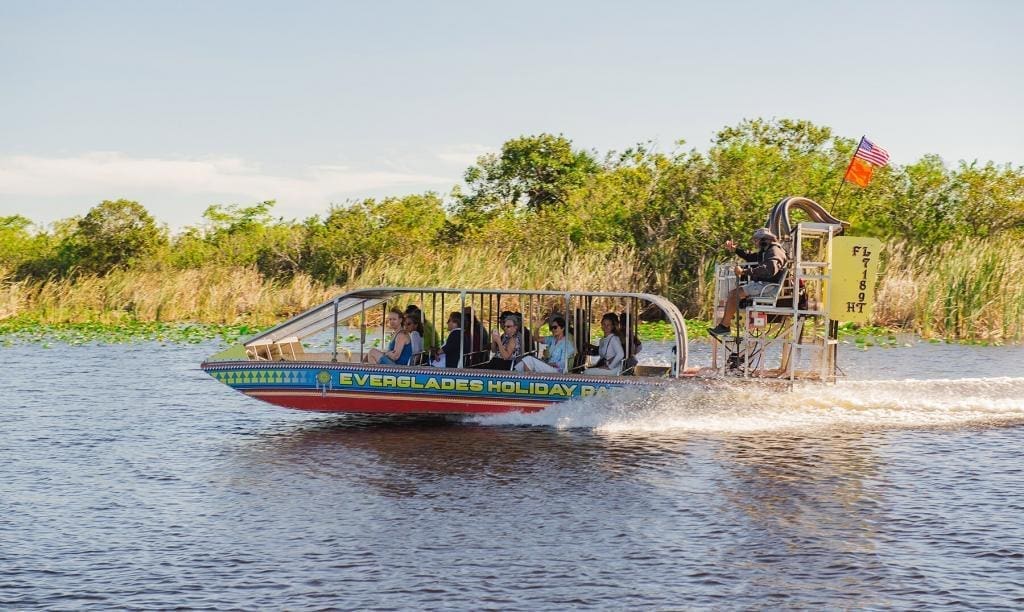
If you have ever wanted to dive into the heart of Florida’s lush wetlands but felt that it was out of reach, you’re in luck. An airboat tour of the Everglades is exactly what you need to experience a stellar blend of excitement and natural beauty.
At Everglades Holiday Park, you can book tickets for this essential tour that boasts the most beautiful views of the Sunshine State. You can choose to go on group airboat adventure tours or private excursions. Whatever your speed, you don’t want to miss out on this opportunity.
AIRBOATS ARE THE OFFICIAL BOAT OF EVERGLADES TOURS
Airboats are the iconic vehicle of the Everglades, and for good reason. The intricate waterways and differing water depths make traversing the landscape daunting and challenging, but with airboats, all the trouble goes away.
14 FUN FACTS ABOUT AIRBOAT RIDES
THE FAMOUS EVERGLADES BOAT

1) AIRBOATS HAVE SEVERAL NICKNAMES.
Airboats are called by many names, such as “swamp boats,” bayou boats,” and “Everglades boats,” among others.
One of the most popular names is “fan boat.” This nickname comes from what is perhaps the most distinctive feature of an airboat – the large, fan-like propellers on the back. They’re visually striking and they’re exactly what makes the airboats uniquely situation for the Everglades.
Ready to experience the fun? Book an airboat ride near me here: Book Tickets
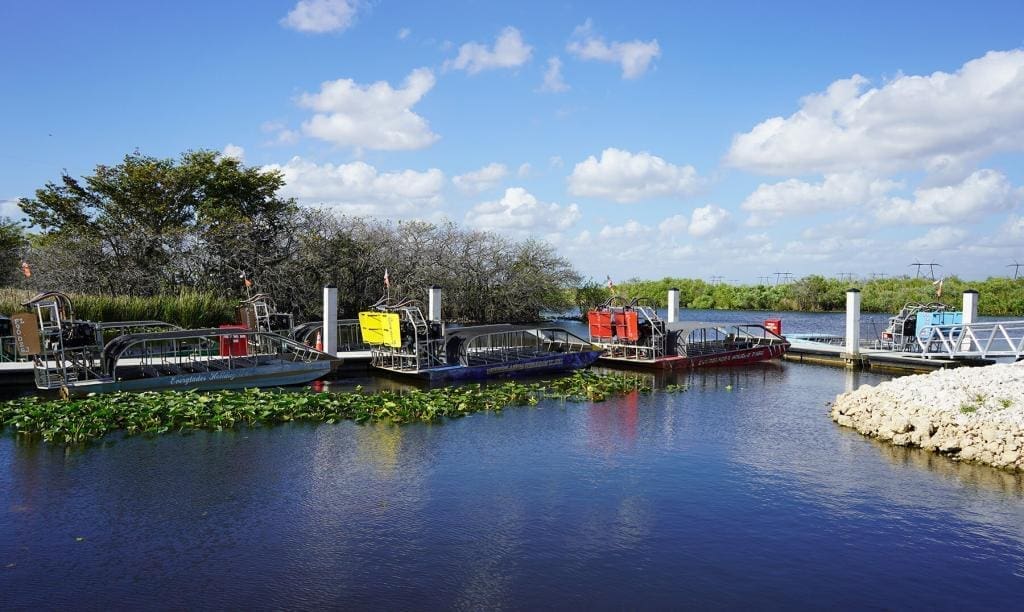
2) AIRBOATS WERE ORIGINALLY BUILT USING AIRCRAFT ENGINES.
Another name you’ll see around is “plane boat.” As you might have already guessed, this name is because airboats used to be made with aircraft engines! Some airboats are still powered by aircraft engines, but it’s becoming more and more uncommon as automotive engines take the front seat. Automotive engines are much more cost-effective and they’re an efficient, alternative power source.
Purchase tickets for an airboat ride near me here: Book an Everglades Tour

3) AIRBOATS ARE MADE FROM STURDY MATERIALS TO ENSURE DURABILITY AND AIRBOAT RIDE PERFORMANCE.
As you might have expected, the material used when creating an airboat has a lot to do with the overall performance, suitability, and durability. Navigating the Everglades is a serious matter and it requires boats that are up to the task.
Airboat hulls are primarily crafted from two materials: aluminum and fiberglass. Both of these materials have unique properties that bring advantages to the airboat’s construction and performance.
Find airboat rides near me here: Buy Everglades Boat Tour Tickets

4) AIRBOAT PROPELLERS CAN GENERATE A PROP WASH OF AROUND 150MPH.
The airboat functions by its ability to create a significant prop wash (the stream of air pushed behind the boat by the propellers). Prop wash is what allows airboats to maneuver easily through dense landscapes at incredible speeds.
Buy Tickets for Everglades airboat rides and tours here.
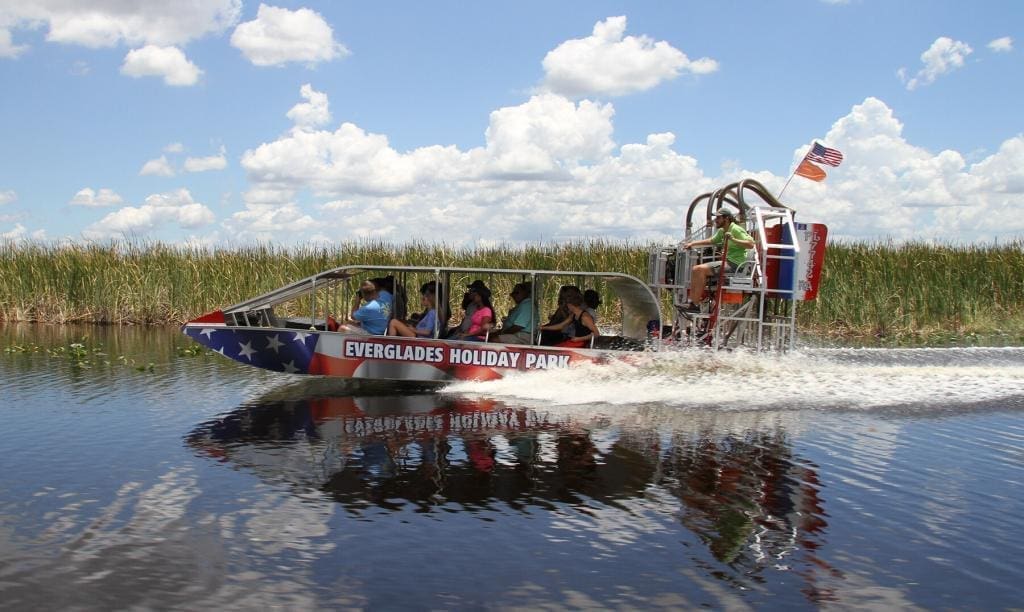
5) AIRBOATS ARE REQUIRED TO HAVE PROPELLER CAGES FOR SAFETY.
The safety of the people on board the airboat is the most important thing, which is why protective cages are placed around the massive propellers. Having the cages installed is pivotal for preventing accidents and injuries.
Everglades Holiday Park airboat rides and tour: Order Tickets
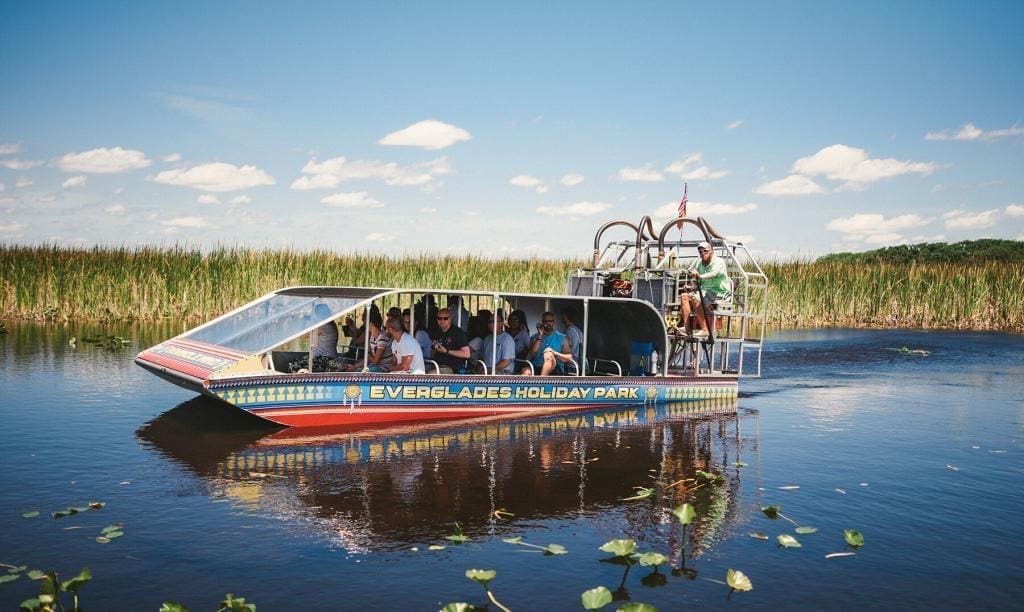
6) AIRBOATS CAN ONLY BE OPERATED BY LICENSED AIRBOAT CAPTAINS.
Airboats are complicated pieces of machinery and hopeful airboat operators are required to take certain steps. Operating it isn’t just a matter of skill, but also of legal and safety compliance. Navigating the challenging and delicate Everglades requires a licensed captain with expert navigation and an adequate understanding of all the related safety protocols.

7) AIRBOATS DON’T HAVE BRAKES OR REVERSE.
Driving an airboat isn’t like driving a car. There are several unique features such as a lack of traditional braking and reverse systems that make operating the vehicle complicated. It is a challenging feature, but it contributes greatly to the swamp boat’s minimal impact on the ecosystem, which makes it all worthwhile.

8) AIRBOATS HAVE MUFFLERS.
While mufflers aren’t a requirement for airboats, they are vastly preferred. The massive propeller makes a lot of noise and anything that can be done to minimize that enhances passenger and captain comfort, but it also decreases the environmental impact of airboat rides.
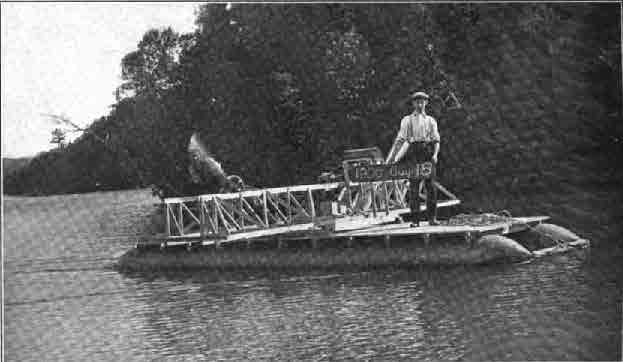
9) AIRBOATS ARE OVER 120 YEARS OLD.
The beginnings of airboats date all the way back to 1905 in Nova Scotia, Canada. Little did that creator know that airboats would become synonymous with swamp and wetland exploration. The history and technological enhancement of these vehicles are incredibly fascinating.
10) THE FIRST AIRBOAT IN FLORIDA WAS IN 1920.
While airboats began in 1905, they didn’t make their way to Florida until around 1920. When airboats did arrive there, the relationship between state and wetland environments was changed for the better and for the rest of time.
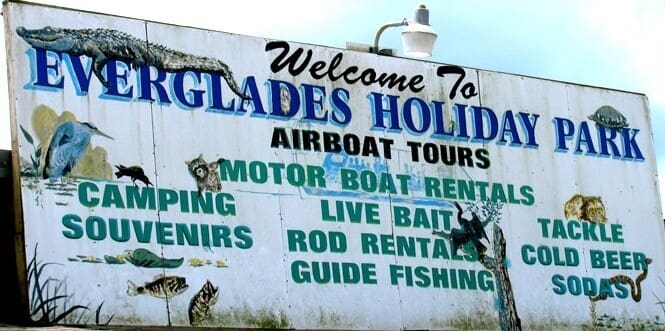
11) AIRBOAT RIDES & EVERGLADES TOURS STARTED IN 1930.
First came navigation of the stunning Everglades landscape, and then came the desire to share that landscape with others. It was the 1930s that marked a pivotal moment in eco-tourism history. Developing Everglades tours opened brand new avenues for exploring the delicate ecosystem and the commercialization of the tours allowed for a greater understanding of the environment.
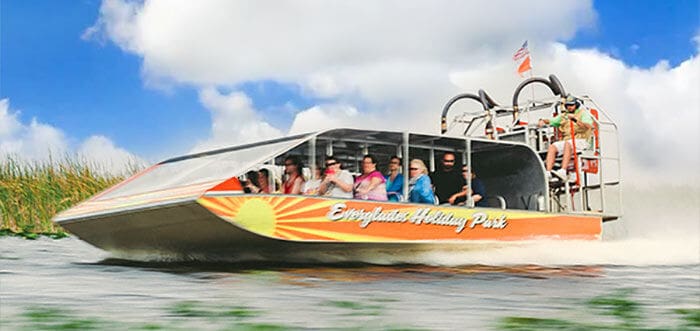
12) AIRBOATS ARE USED RECREATIONALLY FOR MORE THAN EVERGLADES TOURS.
Airboats are well-known and highly favored in swamp areas because of their uncanny ability to navigate difficult terrains. Because of this, they have gained popularity not only as a touring vehicle but also for recreational activities. The versatility and unique design of airboats make them a top choice for outdoor enthusiasts.
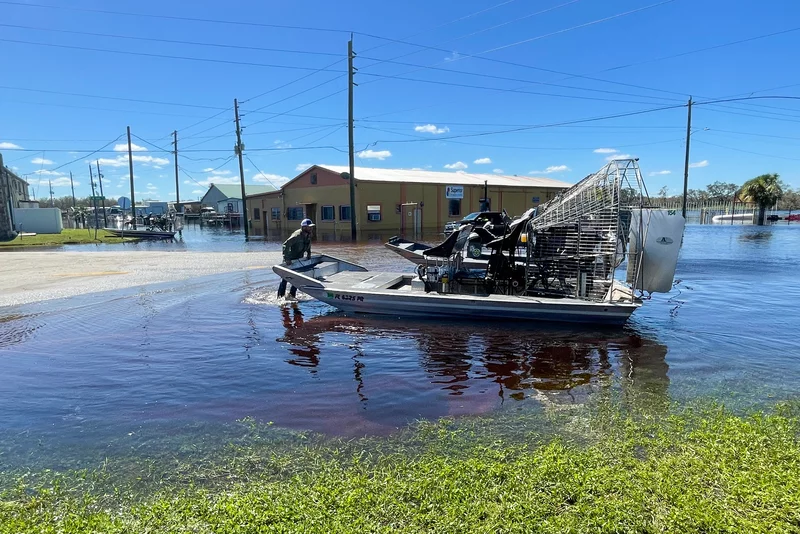
13) AIRBOAT RIDES ARE USED FOR EMERGENCY RESPONSE EFFORTS.
When it comes to reaching shallow waters, marshes, and flooded areas, airboats are the only way to go. Their unique design makes them perfect for reaching emergencies that would otherwise be unreachable.
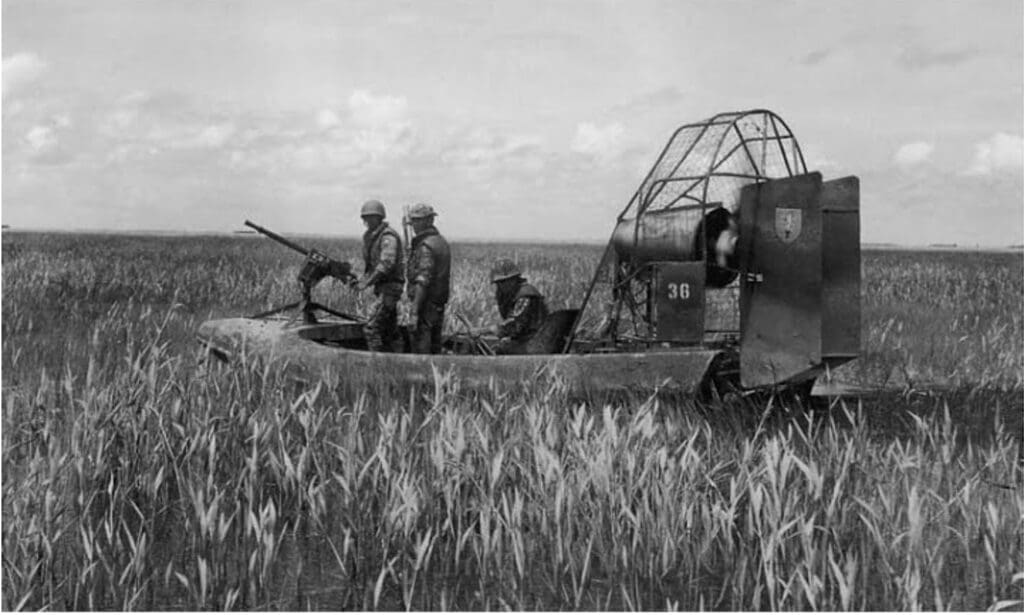
14) AIRBOATS ARE USED BY THE MILITARY.
Airboats have found their place in every major function, including the military. The military utilizes the navigational capabilities of airboats to traverse challenging terrains and mount significant traveling requirements that would be unrealistic without the use of these vehicles.
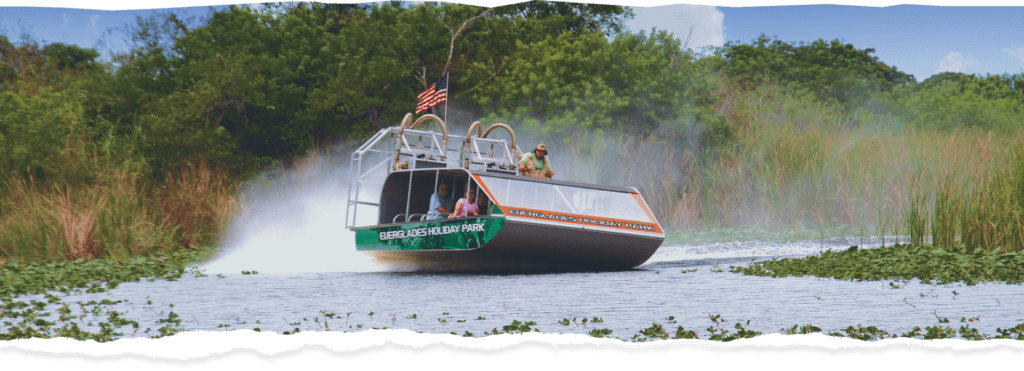
Book an airboat ride near me online with Everglades Tour Tickets
LEARN MORE ABOUT AIRBOAT RIDES
THE USE OF AIRCRAFT ENGINES IN AIRBOATS
- Advantages: Aircraft engines are known to provide significant horsepower, which makes them ideal for propelling the massive fan blades that airboats utilize. Their strength also makes them durable, which is important when navigating difficult terrains.
- Challenges: Aircraft engines are becoming less and less popular because they are costly. Their initial investment and maintenance are both higher costs than automotive engines. Additionally, the fuel is typically aviation gasoline, which is more expensive than car fuel.
ARE AUTOMOTIVE ENGINES IN AIRBOATS SAFER FOR THE ENVIRONMENT?
- Eco-Friendly Trends: Automotive engines, especially the newer models, have much better emission profiles than older aircraft engines such as are used for airboats. The shift towards automotive engines reflects both the economic concerns as well as our growing understanding of environmental care.
- Innovations: Airboats are continuously changing and evolving. The designs are always upgrading to maximize efficiency, durability, and environmental conscientiousness. In the future, we could be seeing options such as the adoption of alternative fuels and hybrid engines.
LICENSING REQUIREMENTS FOR AIRBOAT CAPTAINS
- Certification Process: Airboat captains are required to undergo rigorous certification processes. The steps include training that is both theoretical and practical so that it covers all potential aspects of safety, navigation, and environmental awareness.
- Knowledge of Local Regulations: Being well-versed in local laws and regulations is absolutely crucial for governing waterways and wildlife conservation efforts.
- Regular Renewals and Training: Renewals ensure that captains are always up to date on the latest safety practices and regulations. These renewals will often include additional training sessions to cover any potentially new information.
UNDERSTANDING THE UNIQUE NAVIGATION MECHANICS OF AIRBOATS
LACK OF CONVENTIONAL BRAKING SYSTEMS ON AIRBOATS
- Reliance on Natural Resistance: As stated above, airboats don’t have mechanical brakes. Instead, they rely on the resistance provided by the water. A captain must have a good grasp of what’s required to slow and stop to avoid unfortunate circumstances.
- Skillful Throttle Management: Managing the throttle requires practice and an understanding of momentum. Ideally, the slow to a stop is smooth and puts the boat exactly in the desired location.
- Environmental Factors in Stopping: Water depth, current strength, and wind speed all greatly affect the stopping distance required. To be a safe, effective captain, you must understand the variables and be able to adjust accordingly.
INABILITY TO MOVE IN REVERSE: WHAT THIS MEANS FOR AIRBOAT RIDE PASSENGERS
- Design of Propulsion System: The system utilizes a rear-facing fan or propeller to push the vessel forward through the water. This design means that there is no capability for moving in reverse.
- Importance of Spatial Awareness: Because of this limitation, captains must have an expert awareness of their situation and a plan for navigating their space. Traveling through the Everglades means strategic positioning and, sometimes, routes that don’t seem the most efficient.
- Use of Poles in Shallow Water: One of the reasons airboats are so useful is because they can navigate extremely shallow waters. Sometimes, captains will have to use poles to push the airboat backward, through shallow waters, or away from obsiticals. This technique allows airboats to travel where traditional boats cannot typically navigate, but it also requires careful planning.
TRAINING AND EXPERIENCE IN HANDLING AIRBOATS
- Operator Training: Due to airboats being unique and requiring special navigational skills, extensive training is required to effectively operate one of these vessels. Training includes learning how to slow down, stop, and reverse without the automated functions.
- Passenger Safety: Operators learn how to communicate with passengers about the limitations and safety protocols that come with being a passenger on an airboat. This helps to minimize misunderstandings and mishaps.
THE BIRTH OF THE AIRBOAT
- Early Innovation in Canada:The beginnings of airboats in 1905 ushered in a new era. With technology rapidly advancing at the time, airboats quickly took their place center stage as a new, efficient, and practical means of travel in difficult landscapes.
- The “Ugly Duckling”: The first airboat was constructed by Alexander Graham Bell and Casey Baldwin. It was nicknamed the “Ugly Duckling” because of its humble appearance, but it represented an important breakthrough in boat engineering and design.
- Design and Functionality. The “Ugly Duckling” was powered by an airplane propeller and engine, as you might have guessed. The flat-bottom design was revolutionary in that it allowed the boat to glide over not only water but also icy surfaces.
THE MODERN AIRBOAT YOU SEE ON EVERGLADES TOURS
- Technological Advancements: The airboats you see today are far removed from our humble “Ugly Duckling.” Our modern airboats are equipped with advanced engines (mostly automotive), and navigation systems, and, perhaps most importantly, they’re designed with environmental impact in mind.
- Diverse Applications: Swamp boats are no longer used for the bare minimum travel requirements. Their growth has allowed their application to expand into ecological research, recreational tours, and rescue operations, as well as other things.
THE AIRBOAT’S IMPACT ON THE LOCAL COMMUNITIES AND ECOLOGY
- Access to Remote Areas: Many areas of Florida used to be inaccessible to locals. However, with airboats the way that they are, the Everglades and other wetlands have become reachable. This fact has already had a significant impact on local communities and on ecological studies.
- Cultural Integration: Airboats have become a cultural staple for the Everglades. Airboat rides are recognized as a valuable tool for Florida locals and they’re seen as a symbol of the state’s deep connection with the natural environment that they’ve sworn to protect.